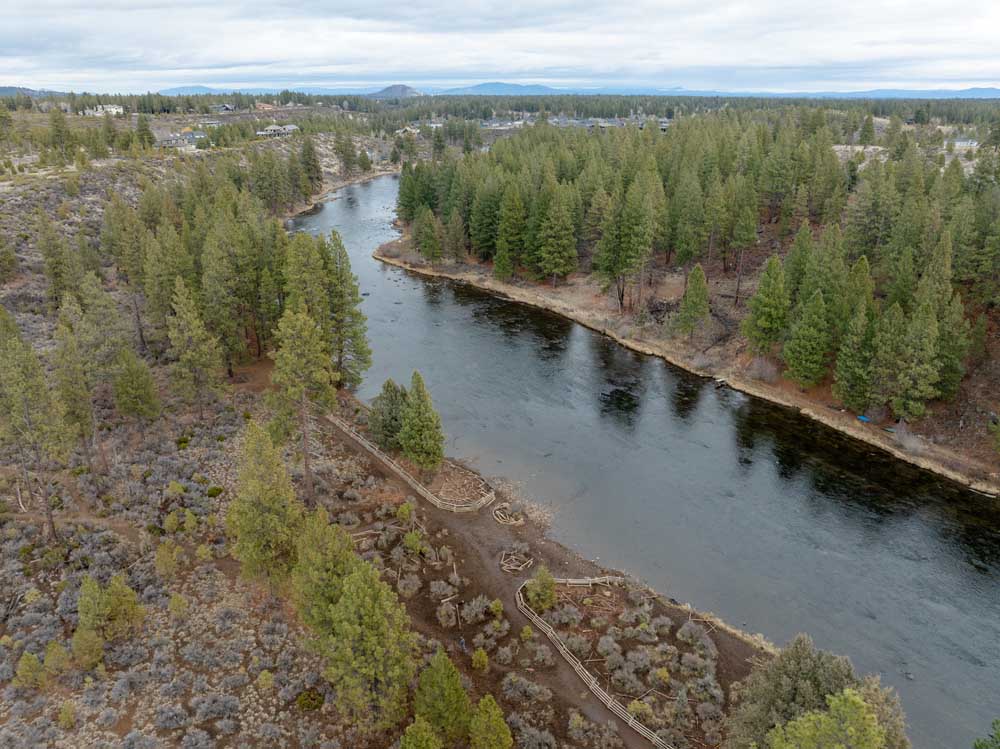Park district takes baby step toward SW Bend footbridge project
Published 5:45 am Thursday, July 18, 2024

- This aerial view shows the proposed location for a footbridge across the Deschutes River in southwest Bend. The Good Dog off-leash area is at the left of the photo and Pilot Butte can be seen in the distance.
The Bend Park & Recreation District has expressed an interest in moving ahead with a decades-old idea to build a footbridge spanning the Deschutes River on the edge of town in southwest Bend. But it’s not clear yet how that will happen.
Park staff hasn’t actively worked on the project in five years.
Trending
That hasn’t changed as of Tuesday, when the park board discussed the status of the footbridge in a meeting.
Instead, the board told district staff to begin thinking about how the agency might be able to approach the contentious and divisive issue.
“We’re not even sure what the first steps would or could be,” said Jodie Barram, chair of the Bend Park & Recreation District board, citing the board’s 2019 decision that shelved the proposal and stopped staff from working on the project.
Barram encouraged taking “incremental steps” using a data-driven approach.
“This board is in a position to show some leadership and have those conversations, come to the table and really dig into this. I’d like for us to do that,” Barram said.
Trending
Read more
Bend park district sees path to bridge the divide over controversial project in SW Bend
Bridge origin story
Ideas first surfaced in the 1990s for a footbridge spanning the Deschutes River that would connect southwest Bend with trails and public forestlands west of the river. In 2012, voters approved a $29 million park district bond that included the bridge in a project list.
The proposed bridge site is just upstream from Bend’s urban growth boundary, close to the northern end of River Bend Drive. Southwest Bend has close to 4,000 housing units, according to city of Bend data. Nearby the proposed site is an 81-acre area identified as an “opportunity area” for growth by the city in 2016.
Under current plans, the bridge could be built on two pieces of land owned by the U.S. Forest Service, but would only be accessible by crossing surrounding private land.
Attempts to build it have been thwarted by opposition, mostly from local landowners, environmental groups and others concerned that a bridge development would violate fundamental river protection laws, harm wildlife and sacrifice the natural state of the river to recreation.
Proponents see the development as a key piece of the Deschutes River Trail, connecting neighborhoods east of the river with miles of trails on the other side and reducing car trips. They say the bridge is necessary to provide Bend residents with equal access to recreation, especially as more houses are built in southwest Bend, and could help the river habitat with restoration projects.
Plans for the bridge were put in the crosshairs of two pieces of legislation in 2017 and 2018, both of which failed. Meanwhile, some supporters formed a nonprofit, called Connect Bend, with the sole mission of getting the bridge built.
With fissures between the groups growing, the park district commissioned a “conflict assessment report” from a third party in 2018.
“The issue has been marked by the loss or simply lack of trust, misinformation, wildly divergent opinions as to facts, lack of data, and polarization among stakeholders,” the report said.
The following year, the district passed a resolution removing the Deschutes footbridge from its five-year project plan, opting to focus on other trail projects.
That is, until “the district, other agencies and the broad community share a vision on how to proceed,” the resolution said.
Bridging the gap to today
Starkly divided opinions rang through the district’s board meeting Tuesday evening. Visitors packed the meeting room at the agency’s headquarters at Riverbend Park, standing against the walls and spilling into the lobby.
Proponents showed their support by wearing varying shades of green shirts, and hollering and clapping after testimony in favor of the bridge.
About 70% of randomly-sampled Bend residents said they support a footbridge spanning the Deschutes, according to a 2023 survey conducted by the parks district; 10% of people were not supportive of the bridge.
Deb Shoen, a park board member, recognized that there is currently no shared vision on the bridge. But she believes more people have voiced their support for the project than any other in recent memory.
“I think it’s going to be very difficult to have community consensus if you don’t listen to the hundreds of folks that have come to us and said ‘we want this,’” Shoen said Tuesday. “I feel like we do have to take a step forward.”
Nathan Hovecamp, a board member who was serving when the park district halted the project in 2019, said he doesn’t see the issue as a choice between providing recreation access or environmental stewardship, but instead as a chance to do both.
He encouraged “bold, courageous” thinking and said park staff should move forward on the project “in the most broad sense.”
“I’m not talking about building the bridge tomorrow. I’m talking about having conversations,” he said.
Henry Stroud, principal planner for the park district, said that there is still work to be done in terms of feasibility studies and preliminary scoping, which ideally would have been conducted before the issue got heated.
“This project became controversial before anyone really had an idea of what this project is,” he said.
Only Donna Owens, the park board’s vice chair, expressed some hesitation about moving forward. She asked staff to come up with a timeline for how long the process might take.
“I don’t know what we’re giving up to put energy into this,” she said. “It’s absolutely huge the amount of time we’d be investing.”
A steep hill going forward
Even with board support, the project still faces a steep regulatory hill to climb.
One major hurdle is that the bridge, in the currently proposed location, would have to be built within a land designation where bridges are not allowed.
The Upper Deschutes was designated as a scenic waterway in Oregon in the late 1980s, giving it protections designed to preserve its natural values and protect private property rights. Bridge building is prohibited on designated waters, unless given an exemption by the agency in charge of the scenic river program, the Oregon Parks and Recreation Department.
A scenic waterway exemption is only the first step in the process and doesn’t take the place of other state or federal environmental assessments, said Stroud, the park district planner.
He said the district tried for the exemption when the bridge was first proposed, but the state parks agency denied the request because it did not include permission from the private landowner.
A spokesperson for Oregon state parks said the agency is not currently reviewing an application for the footbridge.
In November 2023, the state agency sent a letter to the Bend park district explaining its position.
“The short answer is, ‘Nothing has changed since the concept was first introduced several years ago,’” said Chris Havel, associate director of government and policy with state parks, in the letter.
Michelle Healy, recently-hired executive director of the park district, said working with landowners will be essential for the project to move forward.
Whether the bridge is located on Forest Service land or not, the project will need support of the federal agency, said Stroud.
Deschutes National Forest Supervisor Holly Jewkes wrote in a letter to Bend parks on July 9 that the federal agency is not taking a position on the footbridge, recognizing that it had the possibility of providing more access but does not align with management plans of the Forest Service.
“If we gain consensus on a vision of the future, and a pedestrian bridge is compatible with that vision, we would be willing to consider a revision to the (river management plan) to reflect that change,” Jewkes said.








